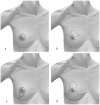New trends in breast cancer surgery: a therapeutic approach increasingly efficacy and respectful of the patient
- PMID: 26712068
- PMCID: PMC4732583
- DOI: 10.11138/gchir/2015.36.4.145
New trends in breast cancer surgery: a therapeutic approach increasingly efficacy and respectful of the patient
Abstract
The surgical management of breast cancer has undergone continuous and profound changes over the last 40 years. The evolution from aggressive and mutilating treatment to conservative approach has been long, but constant, despite the controversies that appeared every time a new procedure came to light. Today, the aesthetic satisfaction of breast cancer patients coupled with the oncological safety is the goal of the modern breast surgeon. Breast-conserving surgery with adjuvant radiotherapy is considered the gold standard approach for patients with early stage breast cancer and the recent introduction of "oncoplastic techniques" has furtherly increased the use of breast-conserving procedures. Mastectomy remains a valid surgical alternative in selected cases and is usually associated with immediate reconstructive procedures. New surgical procedures called "conservative mastectomies" are emerging as techniques that combine oncological safety and cosmesis by entirely removing the breast parenchyma sparing the breast skin and nipple-areola complex. Staging of the axilla has also gradually evolved toward less aggressive approaches with the adoption of sentinel node biopsy and new therapeutic strategies are emerging in patients with a pathological positivity in sentinel lymph node biopsy. The present work will highlight the new surgical treatment options increasingly efficacy and respectful of breast cancer patients.
Figures



References
-
- GLOBOCAN. International Agency for Research on Cancer. 2012;2012
-
- Fisher B, Anderson S, Bryant J, et al. Twenty-year follow-up a randomized trial comparing total mastectomy, lumpectomy, and Lumpectomy plus irradiation for the treatment of invasive breast cancer. N Engl J Med. 2002;347:1233–41. - PubMed
-
- Veronesi U, Cascinelli N, Mariani L, et al. Twenty-year followup of a randomized study comparing breast conserving surgery with radical mastectomy for early breast cancer. N Engl J Med. 2002;347:1227–322. - PubMed
-
- Franceschini G, Terribile D, Fabbri C, et al. Progresses in the-treatment of early breast cancer. A mini-review. Ann Ital Chir. 2008;79(1):17–22. - PubMed
-
- Sanguinetti A, Lucchini R, Santoprete S, et al. Surgical margins in breast-conserving therapy. Current trends and future prospects. Ann Ital Chir. 2013;84(6):595–606. - PubMed
Publication types
MeSH terms
LinkOut - more resources
Full Text Sources
Other Literature Sources
Medical
